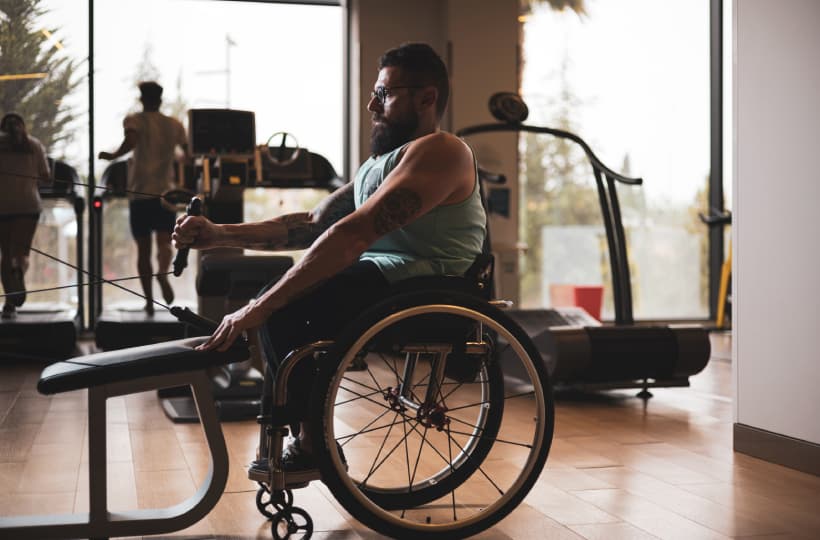If you’re living with limited mobility, it might feel like a challenge to maintain an active lifestyle. More and more adaptive exercises and practices are becoming available for everyone to enjoy the health benefits of physical activity. This guide will explore how to empower your fitness with limited mobility so you can pursue the lifestyle you want.
Take It to the Water
Water-based exercises are an excellent way for people with limited mobility to exercise. The buoyancy of water reduces strain on joints and muscles, making it possible to perform low-impact workouts. In addition, the resistance water provides can help strengthen muscles and improve cardiovascular fitness. Consider trying aquatic activities, such as water aerobics, swimming, or hydrotherapy.
Try Adaptive Exercises and Practices
A variety of adaptive exercises and practices exist to accommodate people with limited mobility. Chair yoga, for example, is a form of yoga practiced while seated. Wheelchair boxing is another option for exercising. It involves throwing punches while seated in a wheelchair, which helps to strengthen the upper body and improve cardiovascular fitness. Resistance bands are also an excellent tool for versatile, equipment-free workouts tailored to your unique abilities.
Seek Professional Coaching
If you don’t know which exercises are right for you, it’s a good idea to get help from a certified trainer who has experience in adaptive fitness. These experts can create personalized workout plans that cater to your specific needs and help you overcome any excuses you might make for not exercising, keeping you accountable for your fitness goals.
Learn How To Use Mobility Aids in Your Workouts
You can incorporate mobility aids, such as walkers and wheelchairs, into your exercise routine to provide extra support and stability. For example, you may use a walker for added balance while doing side leg raises or a wheelchair to get around your gym. You can also explore wheelchair accessories to improve mobility and take your fitness beyond the gym to the great outdoors. Just make sure to consult with a professional to understand how to use mobility aids effectively and safely during workouts.
Stay Mentally Strong
Achieving fitness goals can be just as much about mental strength as physical abilities. People with limited mobility face unique challenges that may require a different mindset and approach to exercise. Stay committed to your fitness journey by setting realistic goals, focusing on small, incremental progress, and celebrating your achievements. Setbacks happen, but your determination and resilience will empower you to overcome them.
Technology-Assisted Workouts: The Future of Adaptive Fitness
Embrace the power of technology to enhance your fitness journey.
Virtual reality (VR) workouts: Immerse yourself in engaging, adaptive exercise experiences.
Exercise: Use video games designed for physical activity, many of which can be adapted for limited mobility.
Smart resistance devices: Utilize equipment that adjusts resistance based on your strength and range of motion.
A 2024 study in the International Journal of Environmental Research and Public Health found that individuals using VR-based adaptive fitness programs showed a 35% increase in exercise adherence compared to traditional methods.
Overcoming Common Barriers to Exercise
1. Fear of Injury
It’s natural to be concerned about potential injuries, especially if you’re new to exercise or have experienced setbacks in the past.
How to address this:
Start with gentle, low-impact exercises and gradually increase intensity.
Work with a certified adaptive fitness trainer to ensure proper form and technique.
Use appropriate safety equipment, such as stabilizing straps or cushioned mats.
2. Lack of Motivation
Staying motivated can be challenging, particularly when progress seems slow.
Try these motivation boosters:
Set small, achievable goals and celebrate each milestone.
Find a workout buddy or join an adaptive fitness community for support.
Track your progress using a fitness app or journal to visualize improvements.
3. Limited Access to Facilities
Not all fitness centers are equipped for individuals with limited mobility.
Solutions to consider:
Look for specialized adaptive fitness centers in your area.
Invest in home exercise equipment designed for limited mobility.
Explore online adaptive fitness classes that can be done from home.
Creating Your Personalized Fitness Plan
Create your own personalized workout plan now
Step 1: Assess Your Current Abilities
Consult with your healthcare provider or a physical therapist to understand your limitations and potential.
Identify activities you enjoy and can perform safely.
Step 2: Set Realistic Goals
Start with short-term goals, such as exercising for 10 minutes three times a week.
Gradually increase duration and frequency as you build strength and stamina.
Step 3: Choose Your Activities
Mix different types of exercises to target various aspects of fitness (e.g., strength, flexibility, cardiovascular health).
Include both structured workouts and everyday activities that increase movement.
Step 4: Schedule Your Workouts
Aim for consistency by setting specific times for exercise.
Be flexible and adjust your schedule as needed to accommodate your energy levels and other commitments.
Step 5: Monitor and Adjust
Keep track of your progress and how you feel after each workout.
Don’t hesitate to modify exercises or try new activities if something isn’t working for you.
Learning how to empower your fitness with limited mobility is an important step toward staying active despite physical challenges. Exploring different adaptive exercises and practices, seeking professional guidance, learning how to use mobility aids effectively, and staying mentally strong are all crucial components of a successful fitness journey.

Dianne Pajo is a Certified Personal Trainer based out of the Chicagoland area with a passion for music, combat sports, and animals. She enjoys competing in amateur boxing and kickboxing, but in her other leisure time, you can find her performing music around the city. She is also a dog mom of 2.
